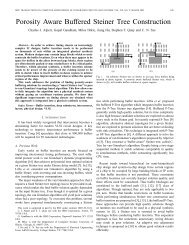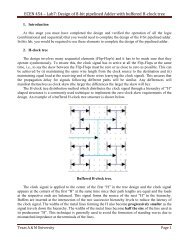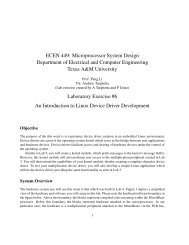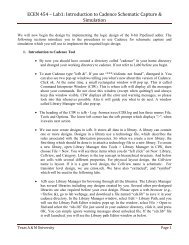Buffer Insertion Basics - Computer Engineering & Systems Group ...
Buffer Insertion Basics - Computer Engineering & Systems Group ...
Buffer Insertion Basics - Computer Engineering & Systems Group ...
You also want an ePaper? Increase the reach of your titles
YUMPU automatically turns print PDFs into web optimized ePapers that Google loves.
In GiLa, the λ u for a leaf node u is the latency constraint at that node. Usually, λ u at a leaf is<br />
a non-positive number. For example, λ u = −3 requires that the latency from the source to node<br />
u is 3. During the bottom-up solution propagation, λ is increased by 1 if a flip-flop is inserted.<br />
Therefore, λ = 0 at the source implies that the latency constraint is satisfied. If the latency at the<br />
source is greater than zero, then the corresponding solution is not feasible (line 2.6.1 of Figure 13).<br />
If the latency at the source is less than zero, the latency constraint can be satisfied by padding<br />
extra flip-flops in the corresponding solution (line 2.6.2.1 of Figure 13). The padding procedure<br />
is called ReFlop(T u ,k) which inserts k flip-flops in the root path of T u . The root path is from<br />
u to either a leaf node or a branch node v and there is no other branch node in-between. The<br />
flip-flops previously inserted on the root path and the newly inserted k flip-flops are redistributed<br />
evenly along the path. When merge solutions from two branches in GiLa, ReFlop is performed<br />
(line 3.3-3.4.1 of Figure 13) for the solutions with smaller latency to ensure that there is at least<br />
one merged solution matching the latency of both branches.<br />
5 Speedup Techniques<br />
Due to dramatically increasing number of buffers inserted in the circuits, algorithms that can efficiently<br />
insert buffers are essential for the design automation tools. In this chapter, several recent<br />
proposed speedup results are introduced and the key techniques are described.<br />
5.1 Recent Speedup Results<br />
This chapter studies buffer insertion in interconnect with a set of possible buffer positions and a<br />
discrete buffer library. In 1990, van Ginneken [11] proposed an O(n 2 ) time dynamic programming<br />
29
















